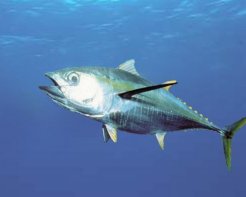
The color is dark metallic brownish blue to dark yellow on the back becoming gray or whitish below. There often is a bluish stripe on the side.
In most bigeye the length of the pectoral fins should help you to identify the species properly. Both the bigeye and yellowfin tuna look similar, but the bigeye tuna have pectoral fins which extend well past their anal fin, while yellowfin tuna have much shorter pectoral fins.
The diet of bigeye tuna includes smaller fish, squid, and crustaceans. Like most other tunas, they tend to feed on what is most abundant in the area.
Bigeye tuna tend to spawn in the southern parts ot the Pacific, The peak spawning is between April and September. Bigeye tuna are approximately 3 years old at first spawning. In the equatorial regions of the Pacific,
The young fish grow very rapidly and by the time they are 1.5 years old they weigh around 7.5 pounds. At 4 years old they weigh approximately 150 pounds. The largest bigeye tuna taken are 10 or more years old.
A bigeye tuna weighing 72kg or 159lbs will produce an estimated 3.3 million eggs per year.
The average length of a bigeye is 100-160 cm or 3-5.3ft
The young are fast growing and weigh about 20kg or 45lbs when they first mature. They can live for about 7 to 8 years if they are not caught.
Bigeye tuna generally are not caught by recreational anglers because they swim far below the surface during the day. Only rarely are they seen on the surface, and then, only momentarily while feeding.